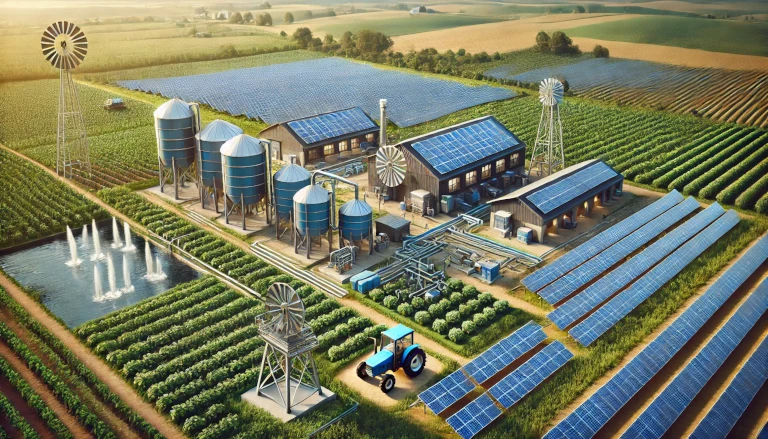The introduction of agri solar panels has transformed the agricultural sector by providing farmers with a sustainable energy source that powers their farms and reduces electricity costs. Agri solar panels are designed to generate clean, renewable energy directly on farmland, benefiting farmers financially and helping the environment. In this guide, we’ll cover everything you need to know about agri solar panels, including their advantages, installation costs, potential challenges, and how they work.
What are Agri Solar Panels? 🌞
Agri solar panels, also known as agricultural solar panels, are solar photovoltaic (PV) systems installed on farmland to harness solar energy and power agricultural operations. These panels are designed to work in harmony with farming activities, either by being installed on non-arable land, above crops, or near areas requiring energy, such as irrigation systems. Agri solar panels support sustainable agriculture by reducing reliance on fossil fuels and providing clean, renewable power for various farming needs.
Why Are Agri Solar Panels Important for Farmers? 🌱💡
Agriculture is an energy-intensive industry, with farmers needing power for irrigation, machinery, refrigeration, and other essential operations. Agri solar panels offer several benefits:
- Reduced Energy Costs 💸: Solar panels allow farmers to generate their own electricity, reducing or even eliminating electricity bills.
- Increased Profitability 📈: By reducing operational costs, farmers can increase profits and reinvest in their farms.
- Environmental Benefits 🌍: Solar power reduces carbon emissions, contributing to a cleaner environment and supporting sustainability.
- Energy Independence 🔋: Farmers gain energy independence, making them less vulnerable to fluctuating electricity prices.
How Do Agri Solar Panels Work? ⚙️
Agri solar panels work like traditional solar PV systems by capturing sunlight and converting it into electrical energy. They are installed in ways that do not interfere with crop growth or livestock. In some cases, they are mounted on elevated structures, allowing crops to grow underneath. The energy generated can be used to power various farm activities, including irrigation pumps, refrigeration systems, and electric farm machinery. Excess energy can often be fed back into the grid, allowing farmers to earn through net metering.
Where Can Agri Solar Panels Be Used? 📍
Agri solar panels can be implemented across various agricultural settings:
- Crop Fields 🌾: Installed above crops to generate energy while shading plants from excessive heat, ideal for certain crops that benefit from partial shade.
- Livestock Farms 🐄: Panels can power milking machines, lights, and ventilation systems on dairy or poultry farms.
- Irrigation and Pumping Systems 🚰: Solar panels can power water pumps for irrigation, reducing dependence on traditional grid electricity.
- Farm Outbuildings and Warehouses 🏚️: Solar installations on barn roofs or other structures can support farm storage and maintenance activities.
Key Benefits of Agri Solar Panels 🌱🌞
- Cost Savings 💰
Solar panels help reduce or eliminate electricity bills, making energy more affordable for farmers. - Increased Crop Yields 🌽
In certain cases, panels can create a microclimate by reducing soil temperature and retaining moisture, which benefits shade-tolerant crops. - Revenue Generation 📊
Through government programs, farmers may receive incentives or be able to sell excess power back to the grid, providing an additional income stream. - Sustainable Farming 🌍
By using renewable energy, farmers contribute to a more sustainable agricultural system, reducing their carbon footprint and promoting eco-friendly practices. - Energy Stability and Reliability 🔋
Solar power provides a stable energy source, protecting farmers from electricity rate hikes and power outages.
Financial Requirements and Cost of Agri Solar Panels 💸
The initial investment in agri solar panels can vary based on the size of the farm and the amount of energy required. On average:
- Small-Scale Installations: ₹1-₹5 lakhs for basic installations on small plots or for specific uses like water pumping.
- Medium to Large-Scale Installations: ₹10-₹20 lakhs for larger installations that power several farm operations.
- Government Subsidies and Loans: Various schemes are available, with subsidies covering up to 30-40% of installation costs, depending on location and project scale.
Payback periods for agri solar panels generally range from 4 to 8 years, depending on energy savings, local electricity rates, and available subsidies.
Challenges and Limitations of Agri Solar Panels ⚠️
While agri solar panels offer numerous benefits, there are a few challenges:
- High Initial Cost 💰: The setup cost can be high, which may be challenging for small-scale farmers without financial assistance.
- Seasonal Energy Production ☀️: Solar panels generate more energy in summer and less in winter or during cloudy seasons, affecting energy availability.
- Maintenance Requirements 🧹: Dust and dirt on panels can reduce efficiency, requiring regular cleaning and upkeep.
- Land Use Conflicts 🌍: In areas with limited land, allocating space for solar panels may compete with other agricultural uses.
- Grid Connectivity 🔌: Farmers in remote areas may face difficulties in connecting to the main power grid, limiting the benefits of net metering.
How Much Do Agri Solar Panels Cost? 💲
- Per-Acre Cost: ₹10-₹20 lakhs for large installations, including mounting, wiring, and inverter systems.
- Government Subsidies: Eligible farmers can access financial assistance programs that significantly reduce upfront costs.
- Annual Maintenance: Maintenance costs are relatively low but necessary, generally ranging from ₹5,000-₹10,000 per year.
Agri Solar Panels for a Sustainable Agricultural Future 🌞🌱
Agri solar panels provide a valuable solution to the challenges faced by modern farmers, combining renewable energy with agricultural productivity. By investing in solar panels, farmers reduce energy costs, create an additional income stream, and promote environmentally friendly practices. While initial investments may be high, financial incentives and lower energy bills make agri solar panels a smart, long-term investment. As technology advances and governments increase support for renewable energy in agriculture, agri solar panels are set to become a standard feature on farms worldwide.
Agri solar panels offer renewable energy solutions tailored to farmers, boosting productivity and sustainability while reducing operational costs across farms.
Discover more from Green Ecosystem - Renewable Energy, Agriculture, and Environmental Sustainability
Subscribe to get the latest posts sent to your email.


